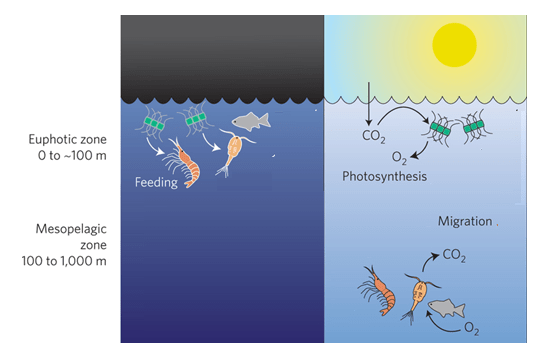Recently, training launch of Short-Range Ballistic Missile ‘Agni-1’ was carried out successfully from APJ Abdul Kalam Island in Odisha.
Agni-I is the 1st in the series which was tested in 1989.
|
Missile |
Range (Km) |
Features |
|
Agni-I |
Medium Range (700-1200) |
|
|
Agni-P |
Medium Range (1000-2000) |
|
|
Agni-II |
Medium Range (2000-2500) |
|
|
Agni-III |
Intermediate Range (Up to 3500) |
|
|
Agni-IV |
Intermediate (3500-4000) |
|
|
Agni-V |
Inter-Continental Ballistic Missile (>5500) |
|
|
Agni-VI |
Inter-Continental Ballistic Missile (8000-10000) |
|
References
Deep sea organisms plays a crucial role in the earth’s carbon cycle through the process of diel vertical migration.
DVM is the largest migration on the planet by biomass which occurs daily in all oceans.

Reference
The Hindu| Diel Vertical Migration (DVM) as a Carbon Sink
The Koyas have moved on from using traditional Indian Bison horns to palm leaves to craft their ‘Permakore’.
‘Bhumi Panduga’, a festival to mark the commencement of the agricultural season will not be held without the Permakore.
Koya tribes
Papikondalu hill range is also called as the’ Bison hill range’ as it is home to the Indian Bison. It got the national park status in 2008.
|
Indian Bison (Indian Gaur) |
|
Reference
The Hindu| Replacing Bison horn with Palm leaf flute
The draft text on the Santiago Network has been adopted by the Parties and sent to the Conference of the Parties (COP) of UNFCCC at COP28 in UAE.
Santiago is the capital of Chile.
References
Recently, the 1st edition of IAADB was held at the Red Fort.
Cultural spaces are being built in Delhi, Kolkata, Mumbai, Ahmedabad, and Varanasi to enrich these cities culturally.
References
|
Other Important News |
|
Dodo (Raphus cucullatus)
|
|
Shidaowan Nuclear Plant
|
|
Ban import of diamonds
|
|
UPI Payment Limit
|
|
Outcomes of Monetary Policy Committee Meeting
|
|
MoU between NMCG-MRCTI
|
|
UN Resolution on Ceasefire
|
|
EU's AI Rules
|
|
Build for Bharat Initiative
|
|
4E Wave movement
|
SIVASAKTHI 1 year